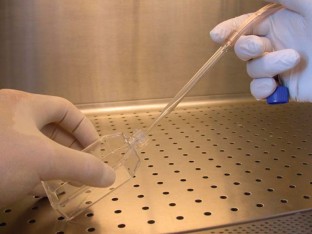Abstract
Cell lines are widely used in biomedical research. This protocol describes the methods used routinely to change the medium and passage the cells. Medium changes keep the cells healthy by providing fresh nutrients, while cell passage or splitting is required to maintain cells in exponential growth. Despite the simplicity of the methods used, each cell line has idiosyncracies. Whether working with one or several cell lines, there is no substitute for knowledge of their needs, including the range of phenotypes and growth patterns under different physical and nutrient conditions. Given the necessary care and attention, most cell lines are easy to maintain and grow.

Similar content being viewed by others
References
Schaeffer, W.I. Usage of vertebrate, invertebrate and plant cell, tissue and organ culture terminology. In Vitro 20, 19–24 (1984).
Freshney, R.I. (ed.) Culture of Animal Cells 4th edn. (Wiley Liss, New York, 2000).
Southam, C.M. Homotransplantation of human cell lines. Bull NY Acad. Med. 34, 416–423 (1958).
Gugel, E.A. & Sanders, M.E. Needle-stick transmission of human colonic adenocarcinoma. N. Engl. J. Med. 315, 1487 (1986).
Lloyd, G. & Jones, N. Infection of laboratory workers with hantavirus acquired from immunocytomas propagated in laboratory rats. J. Infect. 12, 117–125 (1984).
Tedder, R.S. et al. Hepatitis B transmission from a contaminated cryopreservation tank. Lancet 346, 137–140 (1995).
Hummeler, K., Davidson, W.L., Henle, W., LaBoccetta, A.C. & Ruch, H.G. Encephalomyelitis due to infection with Herpesvirus simiae (Herpes B virus); a report of two fatal, laboratory-acquired cases. N. Engl. J. Med. 261, 64–68 (1959).
UKCCCR. UKCCCR guidelines for the use of cell lines in cancer research. Br. J. Cancer 82, 1495–1509 (2000).
Coecke, S. et al. Guidance on good cell culture practice. Altern Lab Anim 33, 261–287 (2005).
Acknowledgements
We thank Ian Freshney for reading and commenting on this set of protocols.
Author information
Authors and Affiliations
Corresponding author
Ethics declarations
Competing interests
The authors declare no competing financial interests.
Rights and permissions
About this article
Cite this article
Masters, J., Stacey, G. Changing medium and passaging cell lines. Nat Protoc 2, 2276–2284 (2007). https://doi.org/10.1038/nprot.2007.319
Published:
Issue Date:
DOI: https://doi.org/10.1038/nprot.2007.319
- Springer Nature Limited
This article is cited by
-
Stem Cell Oriented Exosomes Regulate Cell Proliferation in Hepatoma Carcinoma
Biotechnology and Bioprocess Engineering (2023)
-
A novel feature for monitoring the enzymatic harvesting process of adherent cell cultures based on lens-free imaging
Scientific Reports (2022)
-
Wildtype heterogeneity contributes to clonal variability in genome edited cells
Scientific Reports (2022)




